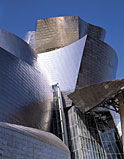|
|
||||||||
|
GUGGENHEIM MUSEUM
BILBAO Bilbao, Spain 1991–97 Gehry's design demonstrates a distinct sensitivity to the museum's surroundings. Located at a bend in the Nervión River on a former industrial site, the building makes the most of its location by forging a strong visual presence in relation to the Museo de Bellas Artes nearby and to the Universidad de Deusto across the river, as well as to additional points along the riverfront. From this position, the museum serves as a gateway to the city's business and historic districts. This building departs from the supposed neutrality of the conventional white cube of museum architecture. Instead, it has uniquely configured exhibition spaces to accommodate installations of contemporary art as well as rectilinear galleries for the presentation of easel painting and traditional sculpture. The building's undulating curves and nonrepetitive geometries were realized with CATIA computer software in its first large-scale use by Gehry's firm. Though metal cladding has long been a hallmark of the architect's work, the museum represents his first use of titanium. In searching for a metal finish that was responsive to changing light conditions, titanium's reflective qualities were found to be ideal. Approximately a third of a millimeter thick, the titanium panels—applied using a traditional locked seam—provide a softening pillowlike effect. A collaborative project between the Solomon R. Guggenheim Foundation and the Basque Government, the museum was conceived as part of an economic redevelopment plan for the largest city in the Basque Country, and has succeeded in creating an iconic identity for Bilbao. The singular economic and cultural impact felt in the wake of its opening in October 1997 has sparked an increased awareness of the powerful force that architecture can wield. |
|||||||
